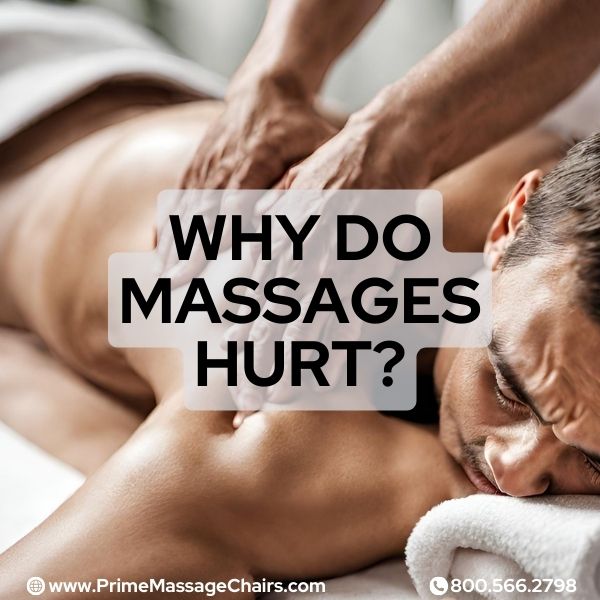
Why Do Massages Hurt?
Why do massages hurt in some instances? Deep tissue massages can sometimes lead to discomfort as they target muscle knots and chronic tension.
This article will guide you through the reasons behind this soreness and how to potentially alleviate it efficiently.
Now let's discuss the details.
Understanding Deep Tissue Massage
Deep tissue massage targets not only the superficial muscles but also the deeper layers of muscle and connective tissue, addressing chronic muscle tension and knots.
Massage therapists use strong pressure with their fingers, hands, and elbows to get there.
This type of massage is more intense than gentle massages and can be likened to a therapeutic workout for your muscles.
During deep tissue therapy, therapists may focus on areas where you feel pain or stiffness. They work on knots in your muscles called trigger points.
This can cause discomfort as the therapist works to release tension and improve circulation in deep muscle layers.
Yet this kind of hurt can potentially lead to feeling better later on.
Next, let’s talk about "Why Does Massage Hurt?".
Why Does Massage Hurt?
The sensation of pain during a massage often stems from the deep pressure applied to work out knots and tension within the muscle fibers, challenging your body's soft tissues in a way similar to exercise.
The nature of deep tissue massage
Deep tissue massage goes deep into your muscles and the connective tissues around them.
Deep tissue massage involves more than gentle touch; it applies firm, targeted pressure to reach tight spots and knots in your muscles.

The masseuse uses firm strokes to get rid of tension, which may help heal injuries and reduce pain. This type of massage can work on scar tissue too, making things feel looser and better over time.
Sometimes this process can make you say "ouch" because it's breaking up those tough areas that cause discomfort.
Picture someone untangling a really knotted rope – that’s kind of what the therapist does to your muscles.
They need to apply enough pressure to stretch and release what's been stiff for so long.
Mild discomfort is common as the therapist works through tense areas, but it should not be excessively painful.
The response of muscles to pressure
As we explore why a massage can hurt, it's clear that the pressing and pushing on your muscles is a big part of it.
Imagine your muscles like tight knots in a rope.
When someone presses hard on these knots, it can feel sore or even painful.

This happens because deep tissue massage works to stretch and loosen up those tight spots where you might have been holding stress or had an injury.
During this kind of therapy, the therapist pushes against your muscles with fingers, elbows, or tools to help them relax.
Initially, your body may react to this pressure by tensing up, a natural response that can contribute to temporary discomfort.
But after some time, your muscles start to give in and soften up. That’s when you begin to feel relief from stiffness and pain as blood flow improves and built-up tension releases.
Potential Benefits of Deep Tissue Massage
Deep tissue massage can potentially help with long-lasting pain and tight muscles. It goes deep to fix problems in the layers of your muscle.
Studies have shown that deep tissue massage can effectively reduce pain and improve function in various conditions, suggesting improved circulation and muscle recovery.
Even though it might hurt, this extra pressure gets rid of knots that cause you a lot of pain.
Regular deep tissue massage may benefit athletes or individuals with chronic stiffness, potentially enhancing muscle flexibility and readiness for physical activity.
It also lowers the chance of injury like sprains or strains.
Plus, if someone already has an injury, this type of therapy can make their recovery quicker and smoother.
Ways to Relieve Soreness after Massage
Discover effective strategies to alleviate post-massage discomfort and maximize the healing benefits, ensuring your recovery is as smooth and swift as possible—read on for our top tips.
Hydration
Drinking plenty of water is key after getting a massage. Your body needs water to get rid of any waste that comes out of your muscles during the massage.
Sometimes, you might feel sore after a massage because your muscles are working hard and releasing things they don't need.

Water helps wash these away, which can make you feel better faster.
It's important to stay hydrated before and after your treatment. Adequate hydration supports muscle health and can aid in recovery.
If you're well-hydrated, you may find that any pain fades quicker than if you're not drinking enough fluids.
Next up: stretching can also be an excellent way to keep feeling good post-massage.
Stretching
Stretching helps your muscles after a massage. It can ease the soreness you feel. By stretching, you make your muscles long and flexible.
This is good for healing parts of your body that are tight or cannot move well.

Make sure to stretch gently; do not push too hard. You want to help your body, not hurt it more.
After talking about how stretching can help with post-massage pain, let's look at ways heat therapy might also bring some relief.
Heat therapy
After a massage, using heat can soothe your muscles. It makes them less tight and stiff. Try a warm bath or a heating pad on the spots that hurt. This helps your body feel better faster.
Be sure to drink lots of water too. Heat works well with being hydrated to help with muscle soreness after getting massaged.
Essential oils
Moving from using heat to soothe sore muscles, essential oils offer another way to ease discomfort.
These oils, derived from plants, are known for their pleasant aromas.
While many find topical application of essential oils soothing for muscle soreness, it should be noted that scientific support for their effectiveness in this context is limited and varies.

Some people find that oils like lavender or peppermint help their muscles feel better after a massage. They put the oil right on places that hurt or make the whole area smell nice with a diffuser.
In addition to their pleasant aromas, essential oils may provide topical relief and can be soothing, potentially helping to reduce swelling and discomfort.
Rest
After talking about how essential oils can ease soreness, it's also important to focus on rest.
Your body heals itself when you sleep or take a break. After a deep tissue massage, your muscles may feel like they've had a workout.

They need time to recover. Lying down or taking naps helps your muscles relax and rebuild stronger than before.
Make sure to give yourself plenty of downtime after therapy for your muscles and tendons.
Listen to what your body tells you; if you're tired, rest is the best medicine. Don't rush back into heavy activities right away – this could harm more than help!
Take it easy and allow healing inside those overworked parts of you by resting well after a massage session.
When to Speak Up during a Massage
You have control over how much pressure the massage therapist uses. If it ever feels too strong or painful, you should tell them right away.

- Let your therapist know if the touch hurts and ask for lighter pressure.
- Speak up if you are uncomfortable in any way, like if the room is too cold or the music is too loud.
- Share any allergies to oils or lotions they might use during your session.
- Tell your therapist about areas of your body that are sore before starting so they can be careful.
- Mention any medical conditions such as skin issues, recent injuries, or chronic pain areas.
- Ask questions about what type of massage they are doing if it's causing discomfort.
- It's essential to communicate immediately if any aspect of the massage feels unsafe or uncomfortable, trusting your instincts for your comfort and safety.
When to Consult a Doctor
Sometimes speaking up during a session isn't enough. If pain continues, it might be time to call a doctor.
Please note that the information provided in this article is for educational and informational purposes only and is not intended as a substitute for professional medical advice, diagnosis, or treatment.
Always seek the advice of your physician or other qualified health provider with any questions you may have regarding a medical condition.
Never disregard professional medical advice or delay in seeking it because of something you have read in this article.
Please consult with your doctor if you have pre-existing medical conditions and get approval for massage before starting any massage sessions.
Here are some signs that you should get medical help:
- Your pain is sharp or severe.
- Pain lasts more than two days after your massage.
- You have swelling or bruising that doesn't go away.
- Feeling sick like you have a fever comes after getting massaged.
- Massage brings on tingling, numbness, or weakness in parts of your body.
- Trouble moving around easily happens because the pain is too much.
If you experience any of these symptoms, it's important to consult a healthcare professional promptly for appropriate advice and treatment.
It's important if you already know about health problems you have, like blood clots or cancer.
Always be safe and check with a healthcare professional if something feels wrong after getting massaged.
FAQs
Why does it hurt when I get a massage?
Massage pain often arises from the therapist working out tight muscles, adhesions, or knots, which, while temporarily uncomfortable, can lead to increased flexibility and relaxation.
Is it normal for my foot to hurt during a foot massage?
Yes, your feet might hurt during a massage if the muscles are very tense or if there's an issue like fasciae problems or inflammation.
What should I do if my massage therapy causes pain?
If you feel pain during your massage therapy, tell your therapist right away so they can adjust their technique. You could use ice or cold therapy after the session for any sore spots.
Are all types of massages supposed to be painful?
No, not all massages are meant to be painful. For example, Swedish massages are often gentle and aimed at helping you relax without much discomfort.
Can sports massages help with injury recovery even though they're painful?
Sports massages may be uncomfortable but they target areas affected by sports injuries like knee issues or ligaments problems to aid in rehabilitation and relief.
Is there something I can apply after a painful therapeutic massage for more comfort?
After a therapeutic massage that causes some discomfort, you might want topical treatment such as an ointment for pain relief or try relaxation techniques like mindfulness exercises.
Conclusion
Now that we've answered the question "why do massages hurt?" you should have a much better understanding.
Massages can hurt because they reach deep into your muscles. This helps break up knots and heal sore spots.
It's normal to feel some pain when your therapist works on areas with lots of tension or injury.
After the massage, you might feel better and move easier.
If it hurts too much, always tell your therapist so they can help you in the best way.
Disclaimer:
We do not provide medical advice. The content of this article, including text, graphics, and other material, is for informational purposes only. It is not intended to be a substitute for professional medical advice, diagnosis, or treatment. Always seek the advice of your physician or other qualified health provider with any questions you may have regarding a health condition. Never disregard professional medical advice or delay in seeking it because of something you have read in this article or on our website.
